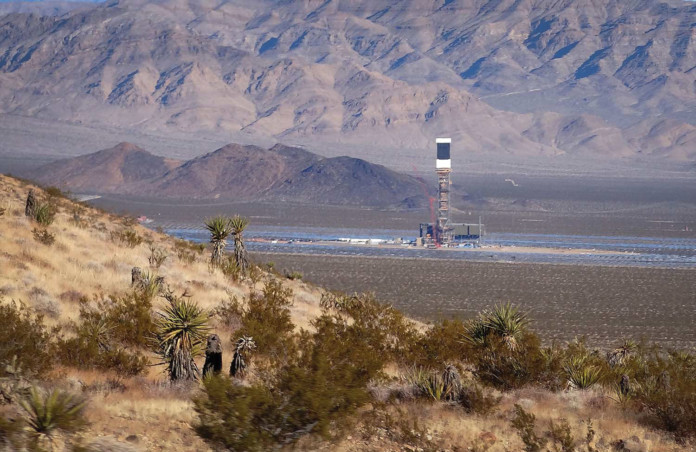Why India Should Soon Move to Solar Tower Technology
The increasing maturity of CSP plants can help India to attain its ambitious target of 100 GW from solar energy by 2022. Srilakshmi G of CSTEP suggests moving quickly to solar tower technology
India is one of the world’s largest energy consumers (ranked third after China and USA) and Greenhouse Gas (GHG) emitters. It is dependent on conventional sources of energy generation which are depleting. The good news is that harnessing renewable energy (RE) sources has become a national priority. The main RE resource that can be readily tapped is solar energy, which is abundant in supply. India is situated slightly above the Equator, with most parts receiving about 300 sunny days in a year.
From a policy perspective, the Jawaharlal Nehru National Solar Mission (JNNSM) – which was announced in 2010 – has played a huge role in setting targets to serve as a means towards harnessing this resource in the country. The primary objective of JNNSM is to reduce India’s dependence on conventional sources of energy and move towards clean energy sources.
Recently, in early 2015, the JNNSM target was revised to a more ambitious one to achieve 100 GW of solar power by 2022. This proposed target of increasing the capacity fivefold in the next seven years is certainly a very aggressive one and definitely a step in the right direction.
Currently, India has 3.74 GW of grid-connected solar power out of which 94% is from Photovoltaics (PV) and the remaining 6% is from Concentrated Solar Power (CSP) technologies. The reason for the high percentage from PV is because it costs lesser than a CSP system of the same capacity.
In India, most operational concentrated solar power (CSP) plants (amounting to a total of about 230 MW) use Parabolic Trough (PT) technology which is already well-established (from both technology and supply chain perspectives). This is mainly due to the high level of maturity that this technology has already attained. These plants are however limited to a 50 MW capacity level. While Linear Fresnel, like PT, is also a mature CSP technology, with high installed capacity in India, Dish technology is generally used for off-grid thermal, standalone applications.
It is evident that the share of CSP in the current solar installed capacity is very small. This can be changed with the advent of Solar Tower (ST) – the other main CSP technology – which has been gaining a lot of importance worldwide.
Solar Tower Technology – Advantages and Challenges
A Solar Tower (ST) or Central Receiver System uses an array of heliostats or mirrors which reflect solar radiation onto a receiver that is placed at the top of a tower. These heliostats have a dual axis control, thereby tracking the sun’s rays during the day in order to reflect maximum amount of radiation onto the receiver. The Heat Transfer Fluid (HTF) in the receiver gets heated up due to solar radiation incident on it and this thermal energy is transferred to the working fluid of a power block, thereby generating electricity.
Grid-connected power needs to be uninterrupted, stable and dispatchable at the utility (100-200 MW) scale. This kind of power may be difficult for PV plants to generate because they can provide electricity only when the sun is shining. Hence they are not suited for very high capacity plants. Also, the cost of available battery storage options is much higher as compared to thermal storage systems, used by CSP plants, thereby making PV plants financially unfeasible. PV technology can certainly be used at times when there is shortage of power but not when it comes to catering to the peak demand load (which usually occurs late in the evening/night when the sun isn’t shining).
CSP technologies, on the other hand, once augmented with thermal energy storage, can provide continuous power which is the prime requirement for grid-connected power. This is especially true for ST technology since higher temperatures are achieved, consequently increasing the thermal storage energy per unit volume of storage block. PV technology becomes more expensive than a CSP system when storage is incorporated into the plant to attain a sustained base load. CSP should be given more attention in the nationally planned solar parks as the investment for evacuation infrastructure is high.
This highly priced infrastructure remains idle during the night if PV technology is employed, whereas, it continues to be utilised if CSP with thermal storage is used.
Other advantages of ST technology (backed by technical studies) include higher solar to electric conversion efficiency than that of any other solar power generating system. The concentration ratios attained and plant capacity utilisation factors (CUFs) are also larger as compared to other solar technologies. Moreover, in ST technology, since the same fluid (molten salt) can be used for heat transfer as well as storage, the need for an extra heat exchanger which is required (between the solar field and the storage block) in a PT plant, is eliminated.
However, like any other technology, ST has some disadvantages as well. For high capacity plants having tower heights of the order of 150 meters, maintenance of the receiver and pumping of the HTF to such heights becomes difficult. For a heliostat field with few thousands of mirrors, cleaning and keeping them dust free is a challenge. Also, since molten salt has a high freezing temperature of about 240°C, it needs to be drained out of the receiver pipes when the plant is not in operation.
From an overall perspective, a trade-off between the challenges and opportunities will have to be considered on a case by case basis.
Global Status and India’s Experience
The largest solar power facility (392 MW) in the world, the Ivanpah Solar Electricity Generating Station (ISEGS) in the Mohave Desert of California, uses this technology. ST technology has developed and gained considerable momentum over the last two decades. It has reached a stage of experience such that it is now implementable.
Currently, there are many operational plants (which also use storage) spread out all over the world. The Planta Solar 10 (PS 10), Planta Solar 20 (PS 20) and Gemasolar plants in Spain are few of the first plants to have started commercial power generation in 2007, 2009 and 2011 respectively. There are many utility-scale plants that are under construction (Rice Solar, Crescent Dunes, Khi Solar One etc.) as well. Spain and USA are pioneers in the design, development and execution of this technology.
In India, apart from a couple of small-scale demonstration plants, there are no plants in the pipeline. ACME in India partnered with eSolar, USA to develop a 2.5 MW tower plant in Bikaner, Rajasthan. The plant started production in 2011. SunBorne Energy is setting up a 1 MW solar power tower system with the support of MNRE at the National Institute of Solar Energy (NISE), Gurgaon. The primary aim of this demonstration plant is to devise a method to optimise the heliostat field (with Titan tracker heliostats) using a volumetric air receiver while simultaneously having a provision for thermal storage. This plant is planned to be set-up using regional indigenous resources for most of the system components.
A significant amount of R&D is also being carried out on this technology in various academic institutions of the country, which is a promising sign.
Way Forward
Even though India currently has limited experience, this technology has the potential to take-off in a very major way. While challenges in terms of lack of component availability cannot be ignored, measures to work around these limitations need to be adopted.
With the ‘Make in India’ campaign kicking off, India could have a head start in designing and manufacturing various ST components since there are very few market players worldwide. Indigenisation prospects are favourable for this technology due to India’s huge potential manufacturing base. In addition, skills required for the development of receivers, heliostats and storage can be honed to meet the needs of this technology.
Organisations like CSTEP, as part of the Solar Energy Research Institute for India and the US (SERIIUS) program, are in the process of developing computational tools to model this technology in order to help with pre-feasibility analysis of these plants. The tool also aims to make predictions on the Levelized Cost of Electricity (LCOE), thereby guiding policy makers and investors to make informed decisions. Apart from this, existing tools developed by National Renewable Energy Laboratory like the Solar Advisory Model (SAM), are also available for developers who
want to start investing in this technology.
India has about 0.4 million square km of wastelands available. Studies show that for existing ST plants with grid-connected power the average land requirement per MW is about 3.8 ha (0.038 km2). Even if 1% of the available wasteland in India is utilised, the potential for ST technology is around 105 GW. Therefore, the availability of land should not be a hurdle in the way of developing this technology for commercial use.
Considering a scenario which allows for an increase in the present trend, if around 10% of the target is tapped from solar thermal technologies, the share of CSP will be around 10 GW. Based on present maturity levels of ST technology, it is assumed that it can contribute up to 30% of the CSP share, resulting in approximately 3 GW of installed capacity by 2022.
It is quite evident that this technology might have an important role to play in paving the way for a cleaner and brighter future for India.












[…] under the poverty line, most with no access to electricity. Going solar may just be what it needs.Seen from mid-air as the flight lands, the solar panels can be seen shining in the distance on the e…solar power and once they saw positive results, they expanded and covered the whole airport with […]
Very well presented.Informative and useful. May be in your next article more on the technical aspects of St technology can be presented and the global experience.
Regards,